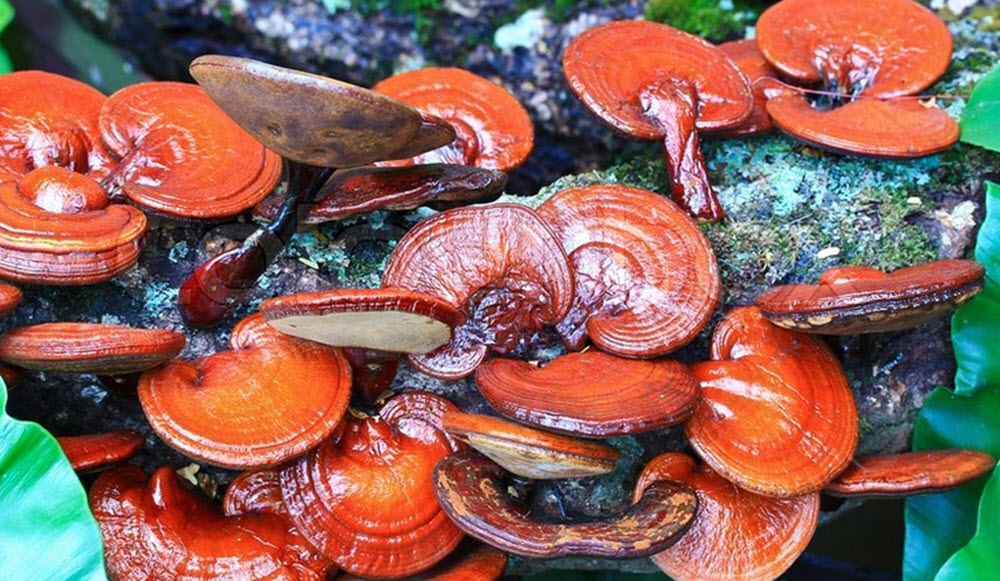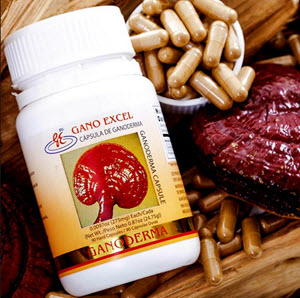Contents
Ganoderma lucidum is a fungi that grows as a parasite or saprotroph on trees in the wild. If you want to cultivate it, you don’t need living trees or even dead logs to do it, since this fungi be successfully grown on wood chips and sawdust.
Just like many other members of the genus Ganoderma, this fungus contains fungal immunomodulatory proteins (FIPs). This is a type of proteins that have immunte building properties, and they can for instance influence the actions of T lymphocytes and B lymphocytes.
The Japanese name for Ganoderma lucidum is Mannentake, which means ten-thousand-year mushroom.

Scientific classification
| Kingdom: | Fungi |
| Division: | Basidiomycota |
| Class: | Agaricomycetes |
| Order: | Polyporales |
| Family: | Ganodermataceae |
| Genus: | Ganoderma |
| Species: | Ganoderma lucidum |
Chinese medicine
 In traditional Chinese medicine, the fresh or dried fruitbody of G. lucidum is used for medicinal purposes. In ancient Chinese medical texts, the term lingzhi is used for this species as well as other close relatives of it, such as G. tsugae and G. lingzhi.
In traditional Chinese medicine, the fresh or dried fruitbody of G. lucidum is used for medicinal purposes. In ancient Chinese medical texts, the term lingzhi is used for this species as well as other close relatives of it, such as G. tsugae and G. lingzhi.
Most Chinese medical recipes for lingzhi preparations involves slicing the fruitbody into very thin slices or pulverizing it, before mixing it with boiling water. Reduce the heat down to a simmer, put a lid on and leave the fungus to simmer for two hours or so. The fruitbody has a bitter taste, and the resulting dark concoction will not taste good. Red fruitbodies tend to be even more bitter than black fruitbodies.
The oldest surviving mentionings of lingzhi medicine are from the Han Dynasty (206-220 AD). The name is composed of the two words ling + zhi. Ling denotes that something is spiritual, mysterious, sacred or divine, while zhi is commonly used to describe plants and fungi with purportedly supernatural powers.
About the fungus
The fairly flat fruitbody of G. Lucidum had a kidney-shaped cap and a purous underside. The texture is corky. The top color varies from reddish to blackish, while the underside changes from white to dull brown with age.
If the carbon dioxide levels are abnormally high where the fungus grows, this will promote stem elongation, and antlers without a cap can occur.
Examples of compounds found in the fruitbody
- Beta-glucan (a polysaccharide)
- Mannitol (a sugar alcohol)
- Coumarin (a fragrant organic compound in the benzopyrone chemical class )
- Genoderol (a sterol)
- Ganoderiol (a sterol)
- Ganodermadiol (a sterol)
- Ganodermanontriol (a sterol)
The fruitbody also contains gnoderic acids that are structurally similar to steroid hormones.
Ganoderma sessile
Earlier, G. lucidum was believed to exist in two growth forms; one – found in North America – where the fruitbody was a big mushroom with little to no stalk, and another one – found mostly in the tropics – where the mushroom was small and had a long, narrow stalk.
Recent molecular investigations have relevealed that this is not two growth forms of G. lucidum; it is actually two different species. The North American one is now known as Ganoderma sessile, a name was bestoved upon it in the early 20th century before it became considered a version of G. lucidum.
